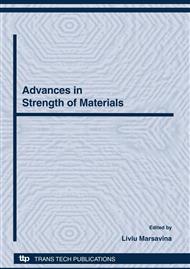p.89
p.97
p.105
p.113
p.123
p.131
p.141
p.153
p.161
Polyurethane Foams Behaviour. Experiments versus Modeling
Abstract:
. Polyurethane foam materials are widely used as cores in sandwich composites, for packing and cushioning. The main characteristics of foams are light weight, high porosity, high crushability and good energy absorption capacity. The paper presents the experimental results obtained for the mechanical properties of polyurethane foams in different loading conditions and the influence of impregnation on the mechanical properties. A 200 kg/m3 density polyurethane foam was investigated in the experimental program in three different Strength of Materials laboratories from Lublin, Bucharest and Timisoara. The paper assesses the possibility to describe the polyurethane foam behaviour trough compression tests, micromechanical models and Finite Element Analysis (FEA). The micromechanical models and Finite Element Analysis could be used successfully for representing the engineering stress – strain behaviour if the compression tests provide reliable material parameters.
Info:
Periodical:
Pages:
123-130
Citation:
Online since:
October 2008
Price:
Сopyright:
© 2009 Trans Tech Publications Ltd. All Rights Reserved
Share:
Citation:


